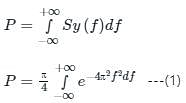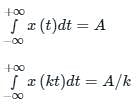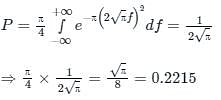Electronics and Communication Engineering (ECE) Exam > Electronics and Communication Engineering (ECE) Questions > Consider a white Gaussian noise process N(t) ...
Start Learning for Free
Consider a white Gaussian noise process N(t) with two-sided power spectral density SN(f) = 0.5 W/Hz as input to a filter with impulse response 0.5e-t2/2 (t is in seconds) resulting in output Y(t). The power in Y(t), in watts, will be:
- a)0.11
- b)0.22
- c)0.33
- d)0.44
Correct answer is option 'B'. Can you explain this answer?
| FREE This question is part of | Download PDF Attempt this Test |
Most Upvoted Answer
Consider a white Gaussian noise process N(t) with two-sided power spec...
Calculation of Power in Output Signal
- Given input power spectral density: SN(f) = 0.5 W/Hz
- Impulse response of the filter: h(t) = 0.5e^(-t^2/2)
Power Spectral Density of Output Signal
- The power spectral density of the output signal is given by: SY(f) = |H(f)|^2 * SN(f)
- |H(f)| is the magnitude of the frequency response of the filter which can be obtained by taking the Fourier transform of h(t)
- By calculating the Fourier transform of h(t) = 0.5e^(-t^2/2), we get H(f) = sqrt(2 * pi) * e^(-2 * pi^2 * f^2)
- Therefore, |H(f)| = sqrt(2 * pi) * e^(-2 * pi^2 * f^2)
- Substituting |H(f)| into the equation for SY(f), we get: SY(f) = 0.5 * 2 * pi * e^(-2 * pi^2 * f^2)
Calculating Total Power in Output Signal
- The total power in the output signal can be obtained by integrating the power spectral density over all frequencies
- P = ∫SY(f) df from -∞ to +∞
- By performing the integration, we get P = 0.5
- Therefore, the power in the output signal Y(t) is 0.5 watts
Therefore, the correct answer is option 'B' which is 0.22 watts.
- Given input power spectral density: SN(f) = 0.5 W/Hz
- Impulse response of the filter: h(t) = 0.5e^(-t^2/2)
Power Spectral Density of Output Signal
- The power spectral density of the output signal is given by: SY(f) = |H(f)|^2 * SN(f)
- |H(f)| is the magnitude of the frequency response of the filter which can be obtained by taking the Fourier transform of h(t)
- By calculating the Fourier transform of h(t) = 0.5e^(-t^2/2), we get H(f) = sqrt(2 * pi) * e^(-2 * pi^2 * f^2)
- Therefore, |H(f)| = sqrt(2 * pi) * e^(-2 * pi^2 * f^2)
- Substituting |H(f)| into the equation for SY(f), we get: SY(f) = 0.5 * 2 * pi * e^(-2 * pi^2 * f^2)
Calculating Total Power in Output Signal
- The total power in the output signal can be obtained by integrating the power spectral density over all frequencies
- P = ∫SY(f) df from -∞ to +∞
- By performing the integration, we get P = 0.5
- Therefore, the power in the output signal Y(t) is 0.5 watts
Therefore, the correct answer is option 'B' which is 0.22 watts.
Free Test
FREE
| Start Free Test |
Community Answer
Consider a white Gaussian noise process N(t) with two-sided power spec...
1. PSD of output = |H(f)|2 PSD of input.
2. Fourier transform of Gaussian Pulse is also Gaussian in nature i.e

3. Average Power from PSD can be calculated as
Application: Given

The output PSD is related to the input PSD as:
Sy(f) = |H(f)|2 SN(f) ----(1)
 the Fourier transform is calculated as:
the Fourier transform is calculated as:

The Fourier transform of h(t) will be:

Substituting this in Equation (1), we get:

The integration of PSD gives power, i.e. the area under the PSD gives power.
Total power P will therefore be:

The area of is always equal to 1, i.e.
is always equal to 1, i.e.

Using the area scaling property, we get:

Applying this property to Equation (1), we can write:

2. Fourier transform of Gaussian Pulse is also Gaussian in nature i.e

3. Average Power from PSD can be calculated as

Application: Given


The output PSD is related to the input PSD as:
Sy(f) = |H(f)|2 SN(f) ----(1)
 the Fourier transform is calculated as:
the Fourier transform is calculated as:
The Fourier transform of h(t) will be:

Substituting this in Equation (1), we get:

The integration of PSD gives power, i.e. the area under the PSD gives power.
Total power P will therefore be:

The area of
 is always equal to 1, i.e.
is always equal to 1, i.e.
Using the area scaling property, we get:

Applying this property to Equation (1), we can write:

Attention Electronics and Communication Engineering (ECE) Students!
To make sure you are not studying endlessly, EduRev has designed Electronics and Communication Engineering (ECE) study material, with Structured Courses, Videos, & Test Series. Plus get personalized analysis, doubt solving and improvement plans to achieve a great score in Electronics and Communication Engineering (ECE).

|
Explore Courses for Electronics and Communication Engineering (ECE) exam
|

|
Similar Electronics and Communication Engineering (ECE) Doubts
Consider a white Gaussian noise process N(t) with two-sided power spectral density SN(f) = 0.5 W/Hz as input to a filter with impulse response 0.5e-t2/2 (t is in seconds) resulting in output Y(t). The power in Y(t), in watts, will be:a)0.11b)0.22c)0.33d)0.44Correct answer is option 'B'. Can you explain this answer?
Question Description
Consider a white Gaussian noise process N(t) with two-sided power spectral density SN(f) = 0.5 W/Hz as input to a filter with impulse response 0.5e-t2/2 (t is in seconds) resulting in output Y(t). The power in Y(t), in watts, will be:a)0.11b)0.22c)0.33d)0.44Correct answer is option 'B'. Can you explain this answer? for Electronics and Communication Engineering (ECE) 2024 is part of Electronics and Communication Engineering (ECE) preparation. The Question and answers have been prepared according to the Electronics and Communication Engineering (ECE) exam syllabus. Information about Consider a white Gaussian noise process N(t) with two-sided power spectral density SN(f) = 0.5 W/Hz as input to a filter with impulse response 0.5e-t2/2 (t is in seconds) resulting in output Y(t). The power in Y(t), in watts, will be:a)0.11b)0.22c)0.33d)0.44Correct answer is option 'B'. Can you explain this answer? covers all topics & solutions for Electronics and Communication Engineering (ECE) 2024 Exam. Find important definitions, questions, meanings, examples, exercises and tests below for Consider a white Gaussian noise process N(t) with two-sided power spectral density SN(f) = 0.5 W/Hz as input to a filter with impulse response 0.5e-t2/2 (t is in seconds) resulting in output Y(t). The power in Y(t), in watts, will be:a)0.11b)0.22c)0.33d)0.44Correct answer is option 'B'. Can you explain this answer?.
Consider a white Gaussian noise process N(t) with two-sided power spectral density SN(f) = 0.5 W/Hz as input to a filter with impulse response 0.5e-t2/2 (t is in seconds) resulting in output Y(t). The power in Y(t), in watts, will be:a)0.11b)0.22c)0.33d)0.44Correct answer is option 'B'. Can you explain this answer? for Electronics and Communication Engineering (ECE) 2024 is part of Electronics and Communication Engineering (ECE) preparation. The Question and answers have been prepared according to the Electronics and Communication Engineering (ECE) exam syllabus. Information about Consider a white Gaussian noise process N(t) with two-sided power spectral density SN(f) = 0.5 W/Hz as input to a filter with impulse response 0.5e-t2/2 (t is in seconds) resulting in output Y(t). The power in Y(t), in watts, will be:a)0.11b)0.22c)0.33d)0.44Correct answer is option 'B'. Can you explain this answer? covers all topics & solutions for Electronics and Communication Engineering (ECE) 2024 Exam. Find important definitions, questions, meanings, examples, exercises and tests below for Consider a white Gaussian noise process N(t) with two-sided power spectral density SN(f) = 0.5 W/Hz as input to a filter with impulse response 0.5e-t2/2 (t is in seconds) resulting in output Y(t). The power in Y(t), in watts, will be:a)0.11b)0.22c)0.33d)0.44Correct answer is option 'B'. Can you explain this answer?.
Solutions for Consider a white Gaussian noise process N(t) with two-sided power spectral density SN(f) = 0.5 W/Hz as input to a filter with impulse response 0.5e-t2/2 (t is in seconds) resulting in output Y(t). The power in Y(t), in watts, will be:a)0.11b)0.22c)0.33d)0.44Correct answer is option 'B'. Can you explain this answer? in English & in Hindi are available as part of our courses for Electronics and Communication Engineering (ECE).
Download more important topics, notes, lectures and mock test series for Electronics and Communication Engineering (ECE) Exam by signing up for free.
Here you can find the meaning of Consider a white Gaussian noise process N(t) with two-sided power spectral density SN(f) = 0.5 W/Hz as input to a filter with impulse response 0.5e-t2/2 (t is in seconds) resulting in output Y(t). The power in Y(t), in watts, will be:a)0.11b)0.22c)0.33d)0.44Correct answer is option 'B'. Can you explain this answer? defined & explained in the simplest way possible. Besides giving the explanation of
Consider a white Gaussian noise process N(t) with two-sided power spectral density SN(f) = 0.5 W/Hz as input to a filter with impulse response 0.5e-t2/2 (t is in seconds) resulting in output Y(t). The power in Y(t), in watts, will be:a)0.11b)0.22c)0.33d)0.44Correct answer is option 'B'. Can you explain this answer?, a detailed solution for Consider a white Gaussian noise process N(t) with two-sided power spectral density SN(f) = 0.5 W/Hz as input to a filter with impulse response 0.5e-t2/2 (t is in seconds) resulting in output Y(t). The power in Y(t), in watts, will be:a)0.11b)0.22c)0.33d)0.44Correct answer is option 'B'. Can you explain this answer? has been provided alongside types of Consider a white Gaussian noise process N(t) with two-sided power spectral density SN(f) = 0.5 W/Hz as input to a filter with impulse response 0.5e-t2/2 (t is in seconds) resulting in output Y(t). The power in Y(t), in watts, will be:a)0.11b)0.22c)0.33d)0.44Correct answer is option 'B'. Can you explain this answer? theory, EduRev gives you an
ample number of questions to practice Consider a white Gaussian noise process N(t) with two-sided power spectral density SN(f) = 0.5 W/Hz as input to a filter with impulse response 0.5e-t2/2 (t is in seconds) resulting in output Y(t). The power in Y(t), in watts, will be:a)0.11b)0.22c)0.33d)0.44Correct answer is option 'B'. Can you explain this answer? tests, examples and also practice Electronics and Communication Engineering (ECE) tests.

|
Explore Courses for Electronics and Communication Engineering (ECE) exam
|

|
Suggested Free Tests
Signup for Free!
Signup to see your scores go up within 7 days! Learn & Practice with 1000+ FREE Notes, Videos & Tests.
























